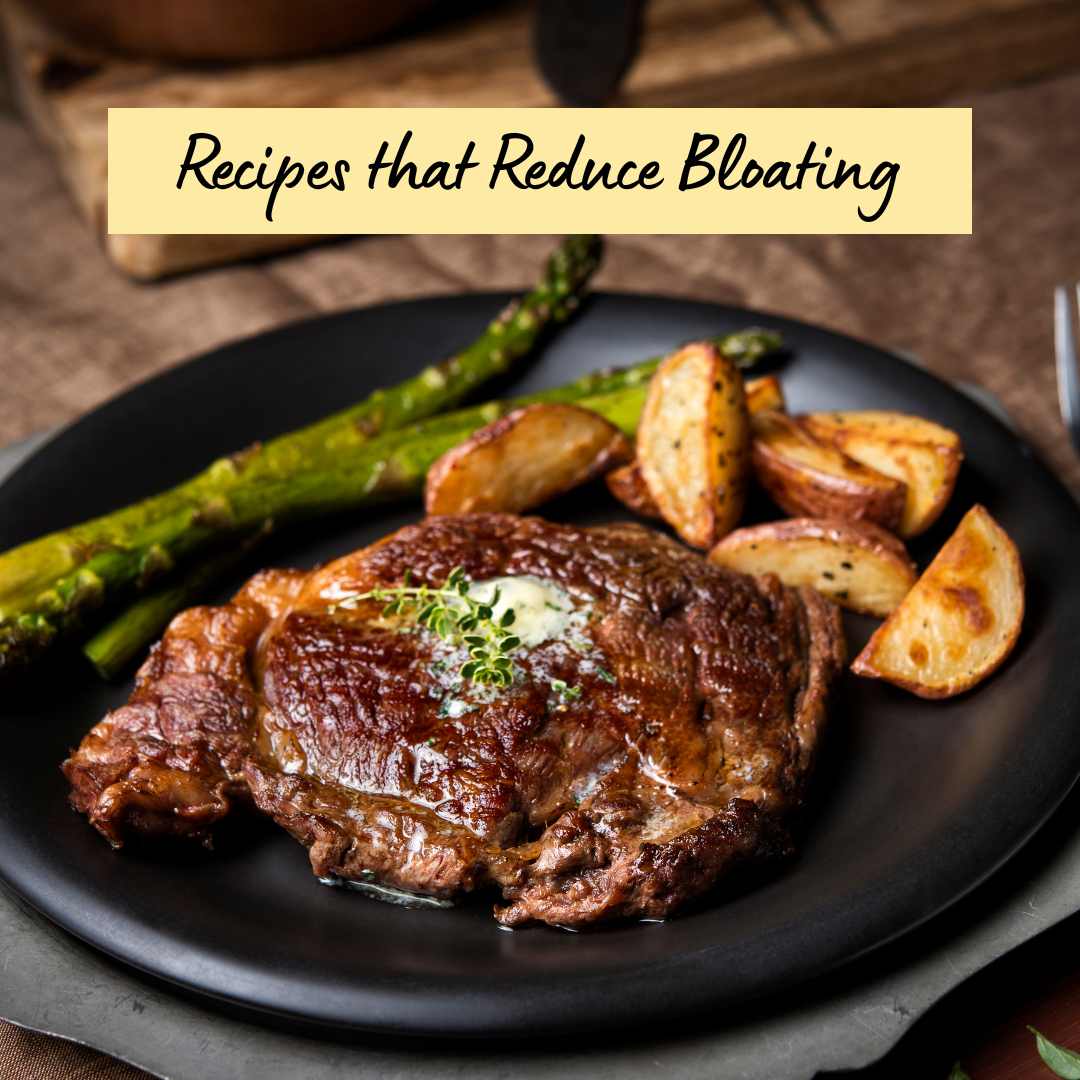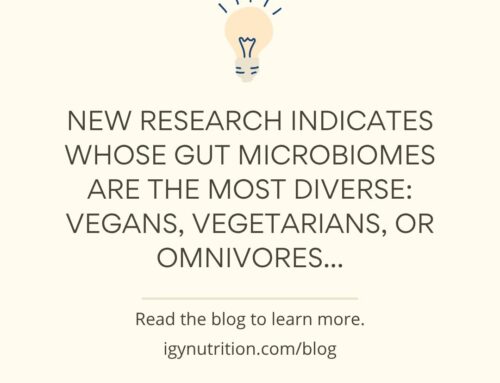Everyone hates feeling bloated. Read on to learn how to reduce bloating and to try out some bloat-free recipes.
Bloated or Distended?
First off, let’s clear some terms up. “Bloating” and “distension” are often accidentally interchanged.
Bloating usually refers to the state of holding on to more water than you typically do. You might feel “puffy,” swollen, or inflamed if you’re bloated. Bloating can make your waistline and cheeks seem a little flabbier than usual.
Distension refers to abnormal extension of the gut due to gas, pregnancy, or constipation (hint: gaining weight over time does not count as distention). Distension often varies in severity throughout the day or week.
Women often experience bloating during certain portions of their menstrual cycles. Everyone experiences bloating occasionally – it’s normal, especially after consuming high-sodium foods.
However, significant distension is not normal. Sure, after Thanksgiving dinner, you might be slightly (emphasis on “slightly”) distended. But needing to change pants or looking like you are several months pregnant is a sign of gastrointestinal distress.
If you experience distension frequently, it’s time to check your gut health.
Causes of Distension
Frequent distension can be caused by a variety of gastrointestinal conditions, including:
- SIBO: Small Intestinal Bacterial Overgrowth (1)
- Dysbiosis: an imbalanced microbiome (2)
- Low stomach acid or enzymes (3)
- Binge-eating disorder or other eating disorders (4)
- Structural issues
SIBO
Extreme distension is a common symptom of SIBO (1). SIBO occurs when too many bacteria (probiotic or harmful) inhabit the small intestine. The microbiome is supposed to reside in the large intestine only.
The stomach and small intestine break down food and absorb specific nutrients. If too many microbes reside there, they can interfere with absorption and cause some nasty symptoms, including distension (1).
If you suspect that you have SIBO, we highly recommend working with a health professional such as a gastroenterologist, a gut-health dietitian, or a gut-health nurse practitioner. Check out our blog on testing for gut conditions to learn about testing for SIBO.
In the meantime, read on to learn about how specific diets can reduce your symptoms.
Dysbiosis
Many of the microorganisms living within us benefit our bodies by regulating metabolism, helping us absorb vitamins from food, supporting our immune system, and much more (2).
The thing is, not all of the microorganisms in our microbiomes are helpful. Some are harmful. These harmful microbes can damage the gut barrier, increase inflammation, and wreak havoc on our metabolisms, hormones, immune systems, and mental health (2).
Plus, they can cause uncomfortable digestive issues like gas, distension, and stool irregularity – no fun.
To minimize the gut damage and annoying symptoms the harmful microbes cause and maximize the benefits helpful microbes confer, we want lots of beneficial microbes and very few harmful microbes to live in our guts (2).
In a healthy microbiome, there are many more beneficial microbes than harmful microbes. The fewer harmful microbes there are, the healthier the biome is.
In an unhealthy microbiome, there are too many harmful microbes and not enough helpful microbes. This state of imbalance is called dysbiosis.
Feeding harmful microbes foods that they can ferment – aka, foods they can eat and produce gas from – may exacerbate distension and propel the dysbiosis you already have (2).
Therefore, diets that minimize fermentable food intake may improve distension symptoms (2).
However, please note that if you are experiencing these symptoms, it is crucial to work with a healthcare professional who is educated on the gut microbiome to adequately and healthily overcome your condition.
Cedars Sinai Diet
One of the best diets for people who struggle with distention is the Cedars Sinai diet. It was developed by Dr. Mark Pimentel, a leading SIBO and gut microbiome researcher (5).
It is also called the “low-fermentation diet” because it recommends foods not easily fermented by microbes living in the gut (5).
This diet may improve symptoms of distention. It is not a cure-all, but knowing which foods ferment in the gut can be valuable information when attempting to reduce symptoms.
The diet requires that you limit or cut out (5):
- Fructose, a sugar found in fruit and milk products
- Table sugar
- Fake sugar, sweeteners, and additives
- Gluten, oatmeal, and brown rice
- Legumes (lentils, beans, peas)
- Cruciferous vegetables (Brussels sprouts, broccoli, cabbage, etc.)
- Reduce fiber intake to under 25g per day
It asks that you prioritize your intake of (5):
- Easy-to-digest carbs, like:
- White rice
- White potatoes
- Healthy fats
- Nuts, avocados, healthy oils such as coconut oil, avocado oil, and olive oil
- Proteins such as:
- Fish
- Poultry
- Red meat
- Eggs
- Vegetables that are easy to digest (cook them if you can)
- Asparagus
- Spinach
- Mushrooms
- Peppers
- Avocado
- Beet
- Berries
- Other fruits are a no-go
Try this diet out to reduce your distention. Stay hydrated and consume the same amount of caffeine you usually do while consuming this diet to give it a fair shot.
Remember, the Cedars Sinai diet isn’t a perfect fix. You may still have days where you are distended while consuming this diet. If you want a permanent fix, look to a healthcare professional for help to get to the root of your problem.
The recipes listed below align with the Cedars-Sinai diet for combating distension. Let’s jump in!
Breakfast Recipes
Strawberry Smoothie
This refreshing smoothie recipe will perk anyone up no matter the time of year.
Ingredients:
- ½ cup frozen strawberries
- 1 ½ cups almond milk
- 2 tbsp organic additive-free sugar-free nut butter
- We suggest crunchy almond butter
- One handful spinach
- 2 tbsp pumpkin seeds
- Optional: 1 scoop IgY Nutrition powder
Directions:
- Blend your almond milk with your almond butter.
- Add the spinach in and blend.
- Add the strawberries in and blend.
- Add your pumpkin seeds in and blend until there are bite-sized chunks of the seeds in the smoothie.
- Enjoy!
Cream of Rice
Cream of rice is like oatmeal, but it’s creamier and less-fermentable (better for distension). Feel free to switch up your cream of rice for breakfast recipes however you would like.
Ingredients:
- ¼ cup cream of rice
- 1 ¾ cups almond milk
- 2 tbsp organic additive-free sugar-free nut butter
- We suggest crunchy almond butter
- Sliced strawberries
- 2 tbsp pumpkin seeds/pepitas
Directions:
- Prep your cream of rice as it instructs you to on the box. Include your almond milk in this step.
- Melt your almond butter in the microwave and drizzle it on the top of your cream of rice.
- Top with sliced strawberries and pumpkin seeds.
Meaty Omelet
We love eggs here at IgY Nutrition (for various reasons). Check out this omelet recipe to satisfy that craving.
Ingredients:
- Three eggs
- ⅓ cup almond milk
- One handful of chopped spinach
- ½ one chopped bell pepper
- ½ one sliced tomato
- 3 oz cup onion, if tolerated
- ¼ cup ground beef
- 2 ½ tbsp olive oil
- Salt and pepper
- ½ one sliced avocado
Directions:
- Cook your ground beef on medium in 1 tbsp olive oil. Add some salt and pepper to taste.
- Chop and slice your vegetables and begin sauteing them on medium in 1 tbsp oil.
- While your vegetables are cooking, beat your eggs and combine them with the almond milk. Add some salt and pepper into the mix to taste.
- When your meat and vegetables are done, turn the heat off.
- Coat a new pan in a layer of 1 tbsp of oil.
- Pour about ½ of your egg mixture into the pan.
- Top the egg mixture with your meat and vegetables.
- Top this with the rest of your egg mixture.
- Heat the pan to medium and let your omelet begin to cook. Once the bottom side becomes solid, fold the omelet on itself. Let it cook for a few more minutes until the center is no longer liquid either.
- When the omelet is done cooking, put it on a plate and top it with salt, pepper, and sliced avocado.
Thanks for joining us throughout this series on limiting distension. Tune in for more helpful gut tips by following our Instagram, @igynutrition.
References
- Sharma et al. Small Intestinal Bacterial Overgrowth: Comprehensive Review of Diagnosis, Prevention, and Treatment Methods. Cureus. 2020 Jun; 12(6): e8860. Published online 2020 Jun 27. doi: 10.7759/cureus.8860 PMCID: PMC7386065PMID: 32754400 https://www.ncbi.nlm.nih.gov/pmc/articles/PMC7386065/
- Foley A, Burgell R, Barrett JS, Gibson PR. Management Strategies for Abdominal Bloating and Distension. Gastroenterol Hepatol (N Y). 2014 Sep;10(9):561-71. PMID: 27551250; PMCID: PMC4991532. https://pubmed.ncbi.nlm.nih.gov/27551250/
- Fatima R, Aziz M. Achlorhydria. [Updated 2021 Jul 25]. In: StatPearls [Internet]. Treasure Island (FL): StatPearls Publishing; 2022 Jan-. Available from: https://www.ncbi.nlm.nih.gov/books/NBK507793/ https://www.ncbi.nlm.nih.gov/books/NBK507793/
- Werlang ME, Sim LA, Lebow JR, Lacy BE. Assessing for Eating Disorders: A Primer for Gastroenterologists. Am J Gastroenterol. 2021 Jan 1;116(1):68-76. doi: 10.14309/ajg.0000000000001029. PMID: 33229986. https://pubmed.ncbi.nlm.nih.gov/33229986/
- https://cdhf.ca/health-lifestyle/diets-used-for-ibs/#:~:text=The%20Cedars%20Sinai%20Diet%20was,easily%20digested%20starches%20and%20sugars.




